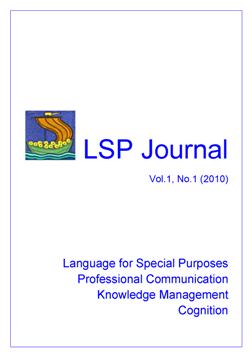Knowledge organisation in LSP texts and dictionaries: a case study
Abstract
In LSP dictionaries the specialised knowledge contained and organised in texts is selected and restructured. This paper is focused on the analysis of a case study: the Dizionario generale plurilingue del Lessico Metalinguistico (DLM – General Multilingual Dictionary of the Metalinguistic Lexicon). The dictionary of linguistics terminology under examination is planned to complement the reference products available in this area of knowledge. In fact, it has a particular outline as the materials it records are directly drawn from the most representative texts produced throughout the history of linguistic speculation. The plan of the DLM establishes that the terminological information stored (definitions, cross-references, formal variants, translations) is directly drawn from the original texts, and not elaborated by the compilers. Therefore, the definitions of the indexed terms are not produced by terminographers: they are ‘defining quotations’ identified and extracted by specialists from the source texts.Specialised texts play an essential role in this project as they are analysed in order to both identify the core concepts used (or introduced) by their authors and to reconstruct the conceptual networks delineated in each of them. In the compilation of the DLM the problematic issues inherent in textual analysis clearly emerge. This is due to the fact that texts are multifaceted units where the various factors related to their structural organisation and informative content interact. The different degrees of ‘density’ of specialised information which is displayed in texts is determined, among others, by the conceptual, communicative, pragmatic, structural, cognitive, and socio-cultural components of LSP texts.
The procedures of retrieval and organisation of specialised knowledge carried out in the DLM project are analysed in this study through the consideration of a sub-section of its terminological inventory, i.e. the metalinguistic units extracted from a text in which focal linguistic issues are discussed. Although this book was produced in the pre-scientific period of the history of linguistics, it was chosen because, in addition to providing interesting contributions to linguistics terminology – considered also from a historical viewpoint –, it yields a model for the arrangement of the conceptual relational network which is being implemented for the DLM. The bi-dimensional character of terminological records of the DLM is being integrated with graphic representations of conceptual relations, which provide a multidimensional outline to the defining section of this dictionary. The visual representation of relational networks provides further terminological information and it also makes available to the users an effective instrument for acquiring a more thorough understanding of the specialised knowledge which is transferred form LSP texts into this dictionary.



